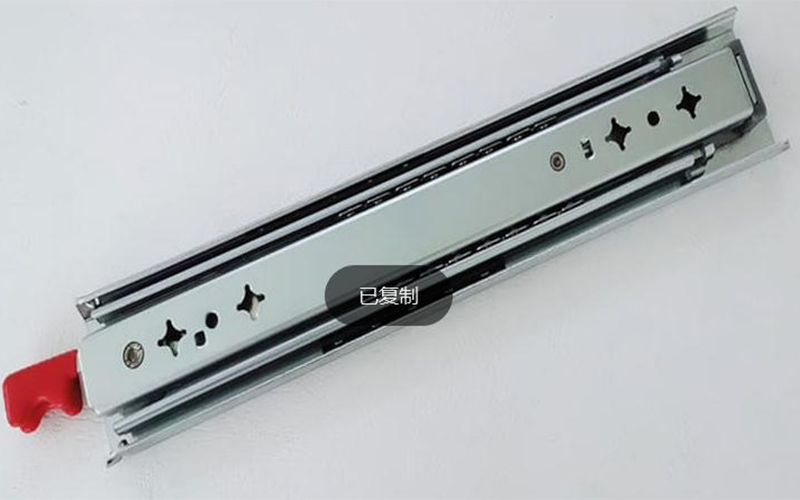
Introduction to Heavy-Duty Slides
Heavy-duty slides, often called heavy-duty ball-bearing slides or linear slides, play a pivotal role in various manufacturing and industrial applications. These robust and durable components are specifically engineered to bear high load capacities, making them the go-to choice for heavy-duty applications.
Their applications are vast and varied, ranging from facilitating the movement of machinery and supporting industrial equipment to managing the operation of heavy storage drawers. These slides are designed to withstand the rigors of demanding environments, providing reliable and efficient performance even under strenuous conditions.
Heavy-duty slides' unique design and structure enable them to handle significant weights and resist wear and tear, ensuring longevity and durability. They are typically constructed from materials that offer high strength and resistance to corrosion, further enhancing their durability and making them suitable for use in various environments.
Understanding the functionality of heavy-duty slides is crucial. They operate on the simple principle of rolling contact, reducing surface friction and allowing smooth and effortless movement. This functionality is essential in manufacturing settings, where equipment needs to be moved or accessed frequently and smoothly.
Recognizing the importance of heavy-duty slides is the first step in making an informed decision for your manufacturing needs. Their ability to handle high loads, durability, and smooth operation make them indispensable in many industrial applications. By understanding their role and functionality, you can better appreciate their contribution to the efficiency and productivity of your manufacturing processes.
Understanding Your Manufacturing Needs
Before delving into the intricacies of heavy-duty slides, it's paramount to comprehensively understand your specific manufacturing needs. This understanding forms the foundation upon which you can make an informed decision about the type of heavy-duty slides that best serve your requirements.
The first step in this process is to evaluate the type of machinery or equipment you're working with. Are you dealing with heavy machinery in a manufacturing plant or using equipment in a more controlled, less intensive environment? The nature and specifications of your machinery or equipment will significantly determine the type of heavy-duty slides you need.
Next, consider the load that your machinery or equipment carries. The weight and size of the load capacity are critical factors that will influence your choice of heavy-duty slides. Slides designed for high load capacities are essential for heavy machinery, while lighter loads may require drawer slides with lower load capacities.
The environmental conditions in which your machinery operates are another crucial consideration. Are your operations conducted in a clean, controlled environment, or do they occur in harsh conditions that may expose your equipment to dust, moisture, or corrosive substances? The environmental conditions can significantly impact the durability and performance of your heavy-duty slides and, thus, should be considered when selecting.
Lastly, consider the frequency of use of your machinery or equipment. Frequent use can lead to wear and tear on the slides, necessitating slides designed for durability and regular operation. On the other hand, machinery or equipment that is used less frequently may not require such robust ball-bearing slides.
By taking the time to understand these aspects of your manufacturing needs, you can ensure that you choose heavy-duty slides that are ideally suited to your specific requirements, thereby optimizing the efficiency and longevity of your operations.
The Importance of Choosing the Right Heavy-Duty Slides
Choosing suitable heavy-duty slides is not just about ensuring smooth operation; it's also about enhancing your machinery's efficiency, safety, and longevity. The suitable slides can reduce wear and tear, minimize downtime, and boost productivity. Conversely, the wrong choice can lead to frequent breakdowns, increased maintenance costs, and even safety hazards.
Types of Heavy-Duty Slides
Heavy-duty slides, a crucial component in various manufacturing and industrial applications, come in multiple types. These types are primarily differentiated by width, directly influencing their load capacity. Here's an expanded description of the different styles based on width:
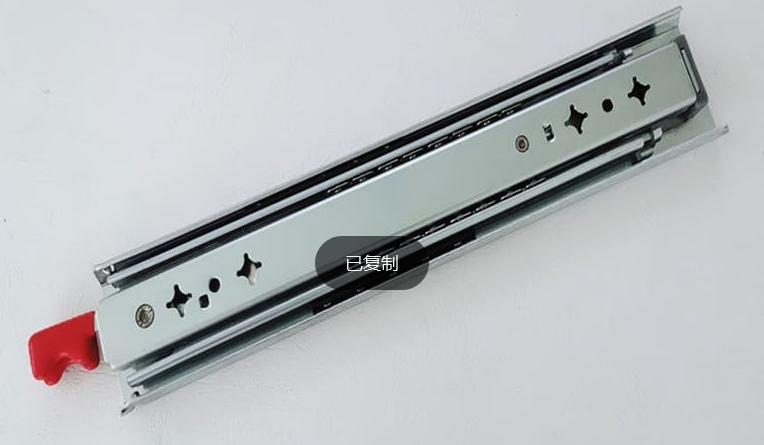
53mm Heavy Duty Slides
These slides, with a width of 53mm, are typically engineered to handle a load capacity ranging from 80-100kg. Despite their relatively minor width, they are designed to offer robust performance. They are the perfect fit for applications that require a delicate balance between space efficiency and load-bearing capacity. These slides are suitable for a wide array of medium-duty applications in both manufacturing and industrial settings. They are often used in applications such as medium-duty storage drawers, machinery, and equipment where space is at a premium but a decent load capacity is still required.
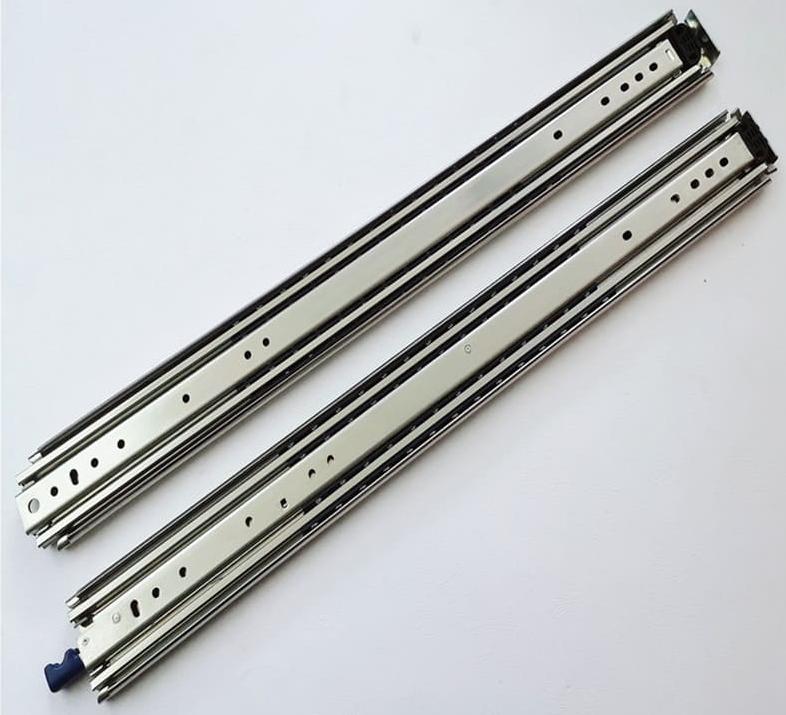
76mm Heavy-Duty Slides
These are the heavyweights of the heavy-duty slides. With a width of 76mm, they are designed to handle significantly higher load capacities, typically around 150-200kg. Their larger size and high load capacity make them the go-to choice for heavy-duty applications requiring substantial weight handling. These slides are commonly used in industrial machinery, heavy storage drawers, and other applications where high load capacity is vital. They offer the strength and durability needed to support heavy loads and withstand the rigors of intensive use.
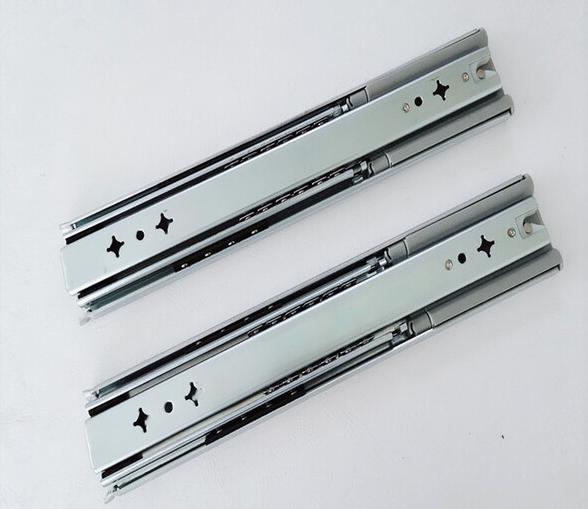
58mm Heavy Duty Slides
These slides strike a middle ground with a width of 58mm. They are designed to handle a load capacity of around 130kg, balancing size and load capacity. These slides are suitable for various applications in both industrial and manufacturing settings where a moderate load capacity is required. They offer more load capacity than the 53mm slides but take up less space than the 76mm slides, making them a versatile choice for many applications.
Each of these types of heavy-duty slides offers unique advantages. Your specific manufacturing needs should guide the choice between them. We need to consider the fact include the weight of the load your machinery or equipment needs to handle, the space available for installing the slides, and the frequency and intensity of use. We consider these factors, you can choose the type of heavy-duty slides that will best meet your needs, enhancing the efficiency and productivity of your operations.
Factors to Consider When Choosing Heavy-Duty Slides
When selecting suitable heavy-duty slides for your manufacturing needs, it's essential to consider several key factors. These factors will significantly influence the slides' performance, durability, and overall suitability for your specific applications. Let's delve deeper into these factors:
Load Capacity: Load capacity is a critical consideration when choosing heavy-duty slides. It refers to the maximum weight the heavy-duty slide can handle without compromising its performance or longevity. It's vital to select a slide with a load capacity that matches or ideally exceeds the weight of the equipment or drawer it will support. Underestimating the load capacity can lead to premature wear and tear, operational inefficiencies, and equipment failure. Therefore, always ensure that the slides you choose are robust enough to handle the weight of your equipment or drawer, with a safety margin to accommodate any unexpected increases in load.
Slide Width: The width of the slide is another critical factor to consider. It directly impacts the load capacity of the heavy-duty drawer slide. More comprehensive slides typically have a higher load capacity and are more stable, making them suitable for heavy-duty applications. However, they also take up more space and may not be ideal for applications with limited space. Therefore, balancing the need for load capacity and stability with the available space is essential when choosing the slide width.
Slide Length: The length of the slide is another crucial factor. The heavy-duty drawer slide should be long enough to support the entire size of the drawer or equipment, ensuring smooth operation and full access. However, it's equally important that the slide is not so long that it interferes with the surrounding space or impedes the process of other equipment. Therefore, before deciding, measure the depth of your drawer or equipment accurately and choose a slide length that fits perfectly.
Material: The slide's material can significantly impact its durability, corrosion resistance, and load capacity. Common materials used to construct heavy-duty slides include steel, stainless steel, and aluminum. Steel slides are known for their high strength and durability, making them can be fit for heavy-duty applications. Stainless steel slides offer excellent corrosion resistance, ideal for harsh or wet environments. Aluminum slides, on the other hand, are lightweight and resistant to rust, making them suitable for applications where weight is a concern. The choice of material should be guided by the specific requirements of your application and the environmental conditions in which the slides will operate.
Extension Type: The extension type of the drawer slide refers to how far the drawer slide can extend from the closed position. Full-extension ball-bearing slides allow for complete access to the drawer or equipment, making them ideal for applications that require full access, such as heavy-duty storage cabinets and industrial machinery. Partial extension slides, on the other hand, may only extend to 75% or 50% of their length. These are suitable for applications where full access is not necessary or where space is limited.
ConsideringConsidering these factors, you can decide and choose the heavy-duty slides that best meet your manufacturing needs. Remember, the right choice of slides can significantly enhance the efficiency and productivity of your operations. In contrast, the wrong choice can lead to operational inefficiencies, increased maintenance costs, and reduced equipment lifespan.
How to Determine the Right Load Capacity
Determining the suitable load capacity for your heavy-duty slides is a critical step in the selection process. The load capacity refers to the maximum weight the slides can handle without compromising their performance or longevity. Here's a more detailed look at how to determine the proper load capacity:
Weight of the Equipment or Drawer: The first step in determining the proper load capacity is to consider the importance of the equipment or drawer that the slides will support. This includes the weight of the equipment or drawer itself and any items that will be stored or transported in it. It's important to remember that the load capacity of the slides must be equal to or greater than this total weight.
Frequency of Use: The frequency of use also plays an important role in determining the correct load capacity. If the equipment or drawer will be used frequently or subjected to heavy loads regularly, opting for slides with a higher load capacity is advisable. This is because frequent use or heavy loads can strain the drawer slides, and slides with a higher load capacity are better equipped to handle this strain over time.
Additional Forces During Operation: It's also important to consider any other forces that may be applied during the operation. For example, if the equipment or drawer is subjected to additional details during movements, such as acceleration or deceleration, these forces can effectively increase the slide load. Therefore, these other forces should be considered when determining the correct load capacity.
Future Upgrades or Changes: It's always a good idea to consider any future upgrades or changes that may increase the slide load. For example, if you plan to add more equipment or increase the weight of the items stored in the drawer in the future, you should choose slides with a load capacity that can accommodate these future changes.
In conclusion, determining the suitable load capacity involves the following:
- Careful consideration of the weight of the equipment or drawer
- The frequency of use
- Any additional forces during the operation
- Any future upgrades or changes
By considering these factors, you can choose heavy-duty slides with a load capacity that meets your current needs and can also accommodate any future changes.
Understanding Slide Width and Its Importance
Understanding heavy-duty slides' width and importance is crucial to selecting the correct slides for your manufacturing needs. The width of the slide not only influences its load capacity but also impacts its fit and functionality within your equipment or drawer. Let's delve deeper into the importance of slide width:
Influence on Load Capacity: The width of the slide is directly proportional to its load capacity. More comprehensive slides typically have a higher load capacity as they have a larger contact area, which allows them to distribute the weight more evenly. This means they can handle heavier loads, making them suitable for heavy-duty applications. On the other hand, narrower slides may have a lower load capacity, but they are more space-efficient, making them ideal for applications where space is a constraint.
Fit and Functionality: The width of the slide also impacts its fit within your equipment or drawer. Ensuring the slide width is compatible with the available space is vital. A too-wide slide may not fit properly, while a too-narrow slide may not provide stability. Therefore, before selecting a slide, it's essential to measure the available space accurately and choose a slide width that fits perfectly.
Impact on Operation: The width of the slide can also impact the operation of your equipment or drawer. More comprehensive slides tend to provide smoother operation as they have a larger contact area, which reduces friction. This can lead to smoother movement and less wear and tear over time. However, more comprehensive slides may require more force, especially under heavy loads.
In conclusion, understanding the width of heavy-duty slides and their importance is crucial in making an informed decision. You can choose suitable heavy-duty slides that meet your specific manufacturing needs by considering different slide widths' load capacity, fit, and operational impact.
Understanding Slide Length and Its Importance
Understanding heavy-duty slides' length and importance is vital in selecting the correct slides for your manufacturing needs. The size of the slide not only determines how far the drawer or equipment can extend but also impacts the overall functionality and efficiency of your operations. Let's explore the importance of slide length in more detail:
Extension and Accessibility: The length of the slide directly determines how far the drawer or equipment can extend. Longer slides allow for more excellent extension, providing full access to the drawer or equipment. This is particularly beneficial in applications that require full access, such as heavy-duty storage cabinets and industrial machinery. On the other hand, shorter slides may be suitable for applications where full extension is not necessary, or space is limited.
Fit and Installation: The length of the slide also impacts its fit within your equipment or drawer. It's essential to ensure that the slide length is compatible with your drawer's or equipment's depth. A slide that is too long may not fit properly or interfere with other components, while a too-short slide may not provide the necessary support or extension. Therefore, before selecting a slide, it's essential to accurately measure your drawer's or equipment's depth and choose a slide length that fits perfectly.
Load Distribution: The length of the slide can also impact the load distribution. Longer slides can distribute the weight evenly across their length, potentially providing better stability and smoother operation. However, they may also require more force to move, especially when fully extended and under heavy loads.
In conclusion, understanding the length of heavy-duty slides and their importance is crucial in making an informed decision. You can choose suitable heavy-duty slides that meet your specific manufacturing needs by considering different slide lengths' extension, fit, and load distribution.
Choosing the Right Material for Your Slides
Choosing the suitable material for your heavy-duty slides is a crucial decision that can significantly impact their performance, durability, and suitability for your specific applications. The slide's material can influence its load capacity, corrosion resistance, weight, and cost. Let's delve deeper into the characteristics and applications of the three common materials used in heavy-duty slides: steel, stainless steel, and aluminum.
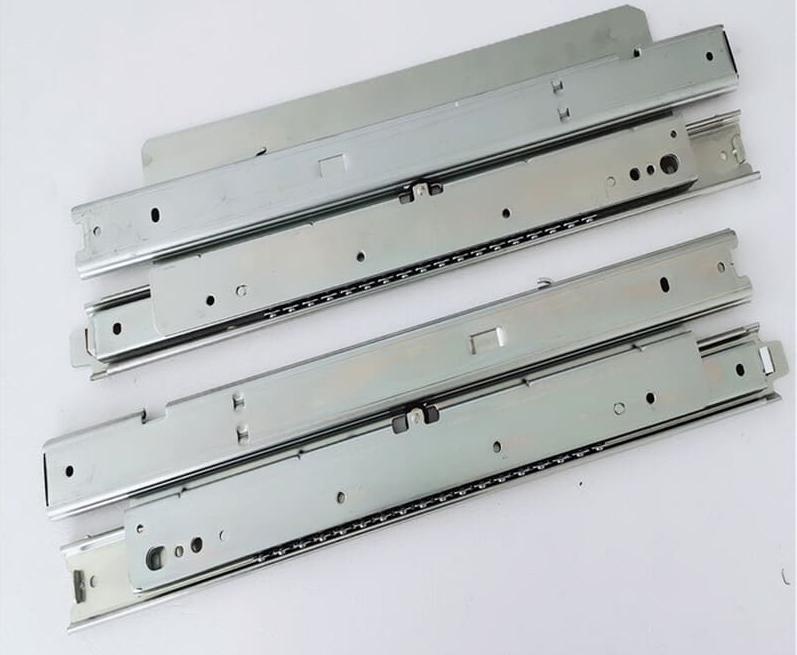
Steel Slides
Steel is a popular material for heavy-duty slides due to its high strength and durability. Steel slides can handle high load capacities, making them ideal for most industrial applications. They are designed to withstand the rigors of heavy use and can provide reliable performance over a long period. However, steel slides can be susceptible to corrosion if exposed to harsh environments or moisture, which can be mitigated with proper coatings or treatments.
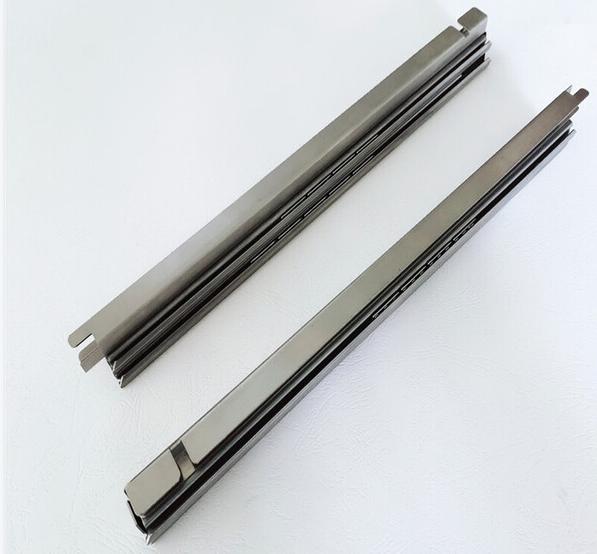
Stainless Steel Slides
Stainless steel slides offer excellent corrosion resistance, making them suitable for use in harsh environments where they may be exposed to moisture, chemicals, or corrosive substances. This feature makes them an excellent choice for food processing, chemical manufacturing, and marine applications. While stainless steel slides may be more expensive than their steel counterparts, their durability and resistance to corrosion can make them a cost-effective choice in the long run.
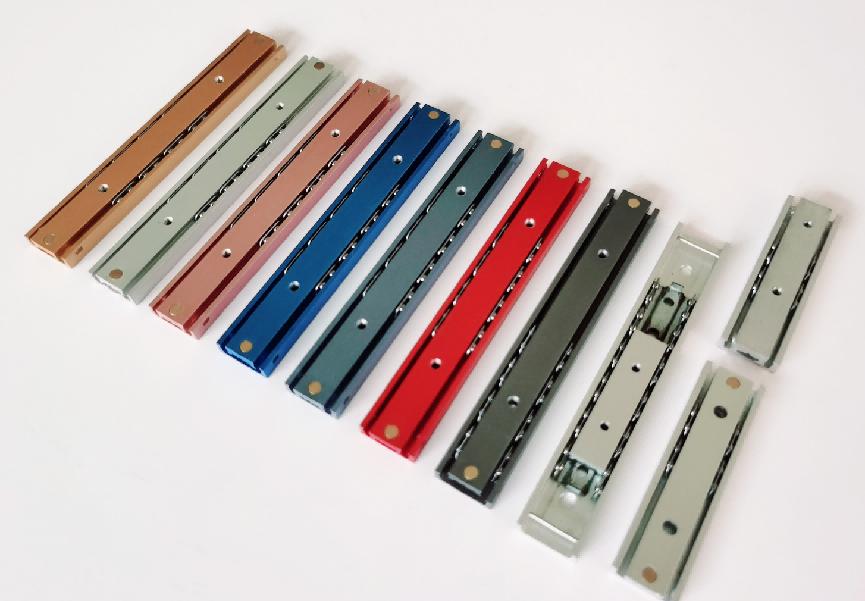
Aluminum Slides
Aluminum slides are lightweight and resistant to rust, making them ideal for applications where weight is a concern. Although lightweight, aluminum slides can still handle a considerable load, making them versatile. They are also corrosion-resistant, making them suitable for use in various environments. However, they may not be as strong or durable as steel or stainless steel slides, so they may not be ideal for heavy-duty applications.
In conclusion, the choice of material for your heavy-duty slides should be guided by the specific requirements of your application and the environmental conditions in which they will operate. By understanding the properties and applications of different materials, you can make an important decision that enhances the performance and longevity of your heavy-duty slides.
Understanding Extension Types and Their Applications
Understanding the different extension types of heavy-duty slides and their specific applications is crucial when choosing the correct slides for your manufacturing needs. The extension type refers to how far the slide can extend from the closed position, and it can significantly impact the functionality and convenience of your equipment or drawers. Let's delve deeper into the two main types of extensions: full extension and partial extension.
Full Extension Slides: As the name suggests, full-extension ball-bearing slides allow for complete access to the drawer or equipment. This means that the drawer or equipment can be pulled out to its full length, providing easy access to all areas. This feature is particularly beneficial for applications that require full access, such as heavy-duty storage cabinets and industrial machinery.
For instance, in a heavy-duty storage cabinet, full extension slides allow you to easily reach items stored at the very back of the drawer, enhancing convenience and efficiency. Similarly, full extension slides can facilitate easy maintenance and repair work in industrial machinery, as they allow complete access to all machine parts.
Partial Extension Slides: Conversely, partial extension slides may only extend to 75% or 50% of their length. This means that a portion of the drawer or equipment remains inside the cabinet or machine even when fully extended. These slides are suitable for applications where full access is not necessary, or space is limited.
For example, a partial extension slide would be ideal in a tight space where a drawer or piece of equipment cannot be fully extended without obstructing a walkway or interfering with other equipment. Similarly, partial extension slides can provide a suitable and cost-effective solution for drawers or equipment where items are not frequently accessed or where things are not stored deep within.
In conclusion, the choice between full extension and partial extension slides should be guided by your specific needs and the constraints of your space. By understanding the different extension types and their applications, you can make an informed decision that enhances the functionality and efficiency of your drawers or equipment.
Installation Considerations for Heavy-Duty Slides
Suitable installation is crucial for the performance and longevity of your heavy-duty slides. This involves ensuring accurate measurements, choosing the correct fasteners, and following the manufacturer's installation instructions. Improper installation can lead to poor performance, increased wear and tear, and a shorter slide lifespan.
Maintenance Tips for Heavy-Duty Slides
Regular maintenance is crucial to ensure your heavy-duty slides' optimal performance and longevity. Without proper care, dust, debris, and wear and tear can compromise the functionality of the slides and lead to premature failure. Here are some maintenance tips to keep your heavy-duty slides in top condition:
Regular Cleaning: Dust, debris, and grime can accumulate on the slides over time, interfering with their smooth operation and potentially causing damage. Regular cleaning is, therefore, essential to maintain the performance of the slides. Use a soft cloth or foam to remove any visible dust or debris from the slides gently. Avoid using harsh or abrasive cleaners that could damage the surface of the slides. If necessary, a mild detergent solution can be used to clean the slides, but ensure they are thoroughly dried afterward to prevent rusting.
Lubrication: Over time, the lubrication on the slides can wear off, leading to increased friction and wear and tear. Regular lubrication is, therefore, crucial to ensure smooth operation and reduce wear and tear. Use a suitable lubricant as recommended by the manufacturer, and apply it to the slide tracks and bearings. Be sure to wipe off any excess oil to prevent it from attracting dust and grime.
Regular Inspections: Regular inspections can help detect potential issues early on, preventing more severe problems. Check for any signs of damage or wear and tear, such as scratches, dents, or rust. Also, check the fasteners to ensure they are still tight and secure. If you notice any issues, addressing them as soon as possible is essential. This may involve repairing or replacing the slides, depending on the severity of the problem.
Adjustments: Heavy-duty slides may require adjustments over time to maintain optimal performance. This could involve adjusting the slides' alignment or the slide mechanism's tension. Always refer to the manufacturer's instructions for guidance on making these adjustments.
By following these tips, you can ensure that your heavy-duty slides continue to operate smoothly and efficiently, extending their lifespan and providing reliable performance for your manufacturing needs.
Common Mistakes to Avoid When Choosing Heavy-Duty Slides
Choosing suitable heavy-duty slides for your manufacturing needs is a core decision that requires careful consideration of various factors. However, it's easy to overlook some of these factors or make mistakes that could compromise the performance and longevity of your slides. Here are some common mistakes to avoid when choosing heavy-duty slides:
Ignoring Load Capacity: One of the most common mistakes is ignoring the load capacity of the slides. Choosing slides with a load capacity that's too low for your needs can lead to premature wear and tear, operational inefficiencies, and potential failure of the slides. Always ensure that the load capacity of the slides matches or exceeds the weight of the equipment or drawer they will support.
Overlooking Slide Length and Width: Another common mistake is overlooking the length and width of the slides. Choosing slides that are too short, too long, too narrow, or too wide can lead to installation issues, inefficient operation, and reduced load capacity. Always measure the depth and width of your cabinet or machine accurately before choosing your slides.
Choosing the Wrong Material: The material of the slides can significantly impact their performance, durability, and suitability for your specific applications. Choosing the wrong material can lead to issues such as corrosion, excessive wear, and reduced load capacity. Always consider your application's environmental conditions and specific requirements when choosing the material for your slides.
Neglecting Extension Type: The extension type of the slides can affect how well they meet your needs. For example, if you need full access to your drawer or equipment, you'll need full extension slides. On the other hand, if space is limited or full access is not necessary, partial extension slides may be more suitable. Neglecting to consider the extension type can lead to inconvenience and inefficient operation.
Skipping Installation and Maintenance Instructions: Proper installation and regular maintenance is crucial for the performance and longevity of your slides. Ignoring the manufacturer's installation instructions or neglecting routine maintenance can lead to poor performance, increased wear and tear, and a shorter slide lifespan.
By avoiding these common mistakes, you can make an informed decision and choose the heavy-duty slides that best meet your manufacturing needs, ensuring optimal performance and longevity.
Case Study: Successful Application of Heavy-Duty Slides in Manufacturing
To further illustrate the importance of choosing suitable heavy-duty slides, let's delve into a real-world case study involving a manufacturing company facing challenges with its heavy-duty storage cabinets.
The Problem: The manufacturing company was experiencing frequent breakdowns with their heavy-duty storage cabinets. These cabinets were used to store heavy tools and equipment, and they were accessed multiple times a day. The company found that their drawer slides were not holding up. They could not handle the heavy loads and frequent use, leading to frequent failures and costly repairs. The breakdowns were also causing disruptions in their operations, leading to decreased productivity.
The Solution: Realizing that the issue lay in the drawer slides, the company consulted with a slide expert to find a solution. The expert recommended switching to high-capacity ball-bearing slides. These heavy-duty slides were designed to handle high load capacities and were built for frequent use. They were made of durable material that could withstand the heavy-duty environment of the manufacturing company.
The Implementation: The company replaced the existing slides in their heavy-duty storage cabinets with the recommended high-capacity ball-bearing slides. The installation process was carried out carefully to ensure proper fit and functionality. The company also implemented a regular maintenance schedule to keep the new slides in optimal condition.
The Result: The company saw a significant breakdown reduction after switching to the high-capacity ball-bearing slides. The new slides were able to handle heavy loads and frequent use without any issues. This led to a decrease in maintenance costs and downtime. Moreover, the smooth operation of the storage cabinets improved the efficiency of their operations, leading to an increase in productivity.
This case study underscores the importance of choosing heavy-duty slides for your manufacturing needs. By understanding your requirements and selecting slides that are designed to meet those requirements, you can improve the efficiency of your operations, and reduce maintenance costs.
Future Trends in Heavy-Duty Slides
As the manufacturing industry evolves and advances, so do the requirements for heavy-duty slides. Manufacturers are constantly finding ways to enhance the efficiency, durability, and customization of these essential components to meet the changing needs of their applications. Here are some future trends we can expect to see in the world of heavy-duty slides:
Increased Load Capacities: As machinery and equipment become more advanced and complex, they often become heavier. This is driving a trend towards slides with higher load capacities. Manufacturers are investing in research and development to create heavy-duty slides that can handle these increased weights without compromising performance or longevity. This means we can expect to see slides in the future that can handle even greater loads than they can today.
Improved Durability: With the increasing cost of machinery and equipment, there's a growing demand for slides that can withstand heavy use over a long period. This is leading to advances in materials and design to improve the durability of heavy-duty slides. We can expect to see slides made from even more durable materials and innovative design features that reduce wear and tear and extend the lifespan of the slides.
Greater Customization: Every manufacturing process is unique, and there's a growing demand for slides that can be customized to meet specific needs. This includes custom lengths, load capacities, materials, and more. Manufacturers are recognizing this need and are offering more options for customization. In the future, we can expect to see even more possibilities for customizing heavy-duty slides to fit the unique requirements of each application perfectly.
Sustainability: With growing awareness about the environmental impact of manufacturing processes, there's a trend towards more sustainable and eco-friendly products. This is likely to influence the production of heavy-duty slides as well. We can expect to see manufacturers adopting more sustainable materials and production processes and possibly even designing recyclable slides with a lower environmental impact.
In conclusion, the future of heavy-duty slides looks promising, with trends pointing towards increased load capacities, improved durability, greater customization, and more sustainable practices. By staying informed about these trends, manufacturers and users of heavy-duty slides can make informed decisions that enhance their operations and contribute to a more sustainable future.
Where to Buy High-Quality Heavy-Duty Slides
When buying high-quality, heavy-duty slides, choosing a reputable supplier that offers durable products, a wide selection, and excellent customer service is essential. One such supplier is HOJOOY Metal.
HOJOOY Metal Product Factory: HOJOOY is a leading manufacturer of high-quality, heavy-duty slides. They offer various slides, including different types, sizes, and load capacities, to meet multiple manufacturing needs. Their ball-bearing slides are designed for durability and performance, making them an excellent choice for heavy-duty applications.
HONGJU's heavy-duty slides are made from high-quality materials to ensure maximum strength and durability. They are designed to handle high load capacities, making them ideal for heavy-duty applications such as machinery, industrial equipment, and heavy storage drawers.
In addition to its high-quality products, HOJOOY also offers excellent customer service. Their knowledgeable team can provide expert advice and guidance to help you choose the right slides for your specific needs. They also offer fast shipping and competitive pricing, making them a convenient and cost-effective choice.
To buy heavy-duty slides from HOJOOY, visit their website, odmslide.com, or contact them directly (sally@zshongju.com.cn). They offer standard and custom options, allowing you to find the perfect slides for your manufacturing needs.
Conclusion: Making the Right Choice for Your Manufacturing Needs
Choosing suitable heavy-duty slides for your manufacturing needs is an important decision that can significantly impact your operations. The suitable slides can enhance your manufacturing process, improve efficiency, reduce downtime, and ultimately contribute to the success and profitability of your operations.
Understanding the different types of heavy-duty slides and their specific features is the first step toward making an informed decision. Consider critical factors such as load capacity, slide length, material, and extension type. Each of these factors plays a core role in determining the performance and suitability of the slides for your specific applications.
Avoid common mistakes such as ignoring load capacity, overlooking slide length and width, choosing the wrong material, and neglecting the extension type. These mistakes can lead to poor performance, increased wear and tear, and a shorter slide lifespan.
Regular maintenance of your heavy-duty slides is also crucial. This includes regular cleaning, lubrication, and inspections to ensure optimal performance and longevity. Proper care can prevent issues before they become serious problems, saving you time and money in the long run.
Keeping up with future trends in heavy-duty slides can also be beneficial. As manufacturing processes continue evolving, so do heavy-duty slide requirements. Staying informed about these trends can help you adapt and make the necessary adjustments to your operations.
Finally, consider where you buy your heavy-duty slides. Choose a reputable supplier like HOJOOY Metal, which offers high-quality products, a wide selection, and excellent customer service. This can ensure you get the best value for your investment.
In conclusion, choosing suitable heavy-duty slides is not just about selecting a product. It's about making a strategic decision that can enhance your manufacturing process, improve your productivity, and contribute to the success of your operations. By creating an informed choice, you can ensure that your heavy-duty slides serve your needs effectively and efficiently for years to come.
Author Description
Mary
Mary is a renowned expert in the field of slide rail design, with an extensive background in mechanical engineering and product development. With her passion for innovation and attention to detail, Mary has become a trusted name in the industry.
Throughout her career, Mary has been instrumental in designing and developing cutting-edge slide rail systems for various applications. Her expertise lies in creating robust and reliable solutions that meet the ever-evolving needs of different industries.
Post time: Jun-26-2023

 Mobile Phone
Mobile Phone E-mail
E-mail